#neural computer engineering
Explore tagged Tumblr posts
Text
You know what really grinds my gears?
Working with people who don't understand how a neural computer works.
Be it some mass ratio optimizing payload engineer, a logistics officer frustrated with the difficulties caused by our team's solutions or just our boss looking for reasons to fire us because they thought our initial cost estimate was "unrealistically high" and are now sorely disappointed at reality, these people are miserable to deal with. On the surface, their complaints make sense; we are seemingly doing a much worse job than everyone else is and anything we come up with creates lots of problems for them. Satisfying all their demands, however, is impossible. With this post I intend to educate my audience on
Neural Computers 101
so that my blog's engineer-heavy audience may understand the inevitable troubles those in my field seemingly summon out of thin air and so that you people will hopefully not bother us quite as much anymore.
First of all, neural matter is extremely resource heavy. Not by mass, mind you; a BNC of 2 kilograms requires only a few dozen grams of whatever standardized or specialized mix of sustenance is preferred in a single martian day. (I'm not going to bother converting that.) The inconvenient part is the sheer variety in the things they need and the waste products they create.
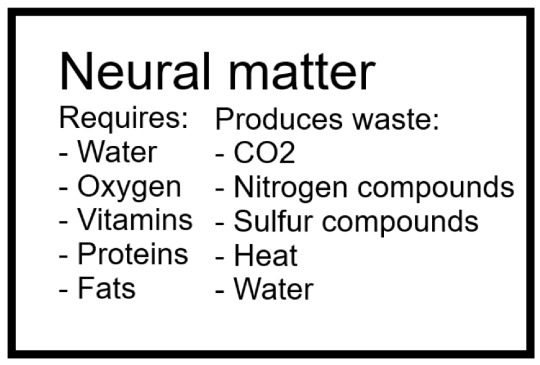
This is just a shortened list, but already it causes problems. If you want to create a self contained system to avoid having to refuel constantly, you will need a lot of mass and a lot of complexity. This is what a typical sustenance diagram for such a system looks like:
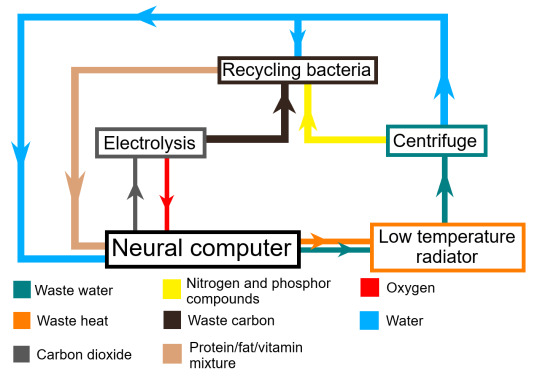
(Keep in mind, this diagram doesn't even have electricity drawn in.)
Typically these systems are even more complicated, with redundancies and extra steps. In any case, this is complicated, energy expensive and a nightmare to maintenance crew. I mean, just keeping the bacterial microbiome alive is a lot of effort!
Second of all, neural matter is extremely vulnerable. Most power plant and rocket designers just round away all temperature changes less than 100 K, but neural matter will outright die if its temperature is just a few kelvin off of the typical value. The same goes for a lot of other things - you'll need some serious temperature regulation, shock absorption, radiation shielding (damn it I wish we had access to the same stuff as those madmen in the JMR) and on top of all of that, you need to consider mental instability!
That last one is kind of the biggest pain in the ass for these things - we need to give them a damn game to play whenever they don't have any real work to deal with or they degrade and start to go insane. (Don't worry, I'm not stupid, I know these things aren't actually sentient, I'm just saying that to illustrate the way they work.) It can't even be the same game - you need to design one based on what the NC is designed to do! (Game is a misleading term by the way; it's not like a traditional video game. No graphics - just a set of variables, functions and parameters on a simple circuit board that the NC can influence.)
And lastly, neural computers are complicated. Dear Olympus are they complicated. There are so so many ways to build them, and the process of deriving which one to use is extremely difficult. You can't blame the NC team for an inappropriate computer if the damn specifications keep changing every week!
There's the always-on, calculation-heavy, simple and slow Pennington circuits, the iconic Gobbs cycle (Bloody love that thing!), the Anesuki thinknet and its derivatives, the Klenowicz for those insane venusians and so so many more frameworks for both ANCs and BNCs. Oh yeah, by the way, the acronyms ANC and BNC actually don't stand for Advanced and Basic Neural Computer respectively. They stand for Type A Neural Computer and Type B Neural Computer. It comes from that revolutionary paper written by Anesuki.
9 notes
·
View notes
Text
New AI noise-canceling headphone technology lets wearers pick which sounds they hear - Technology Org
New Post has been published on https://thedigitalinsider.com/new-ai-noise-canceling-headphone-technology-lets-wearers-pick-which-sounds-they-hear-technology-org/
New AI noise-canceling headphone technology lets wearers pick which sounds they hear - Technology Org
Most anyone who’s used noise-canceling headphones knows that hearing the right noise at the right time can be vital. Someone might want to erase car horns when working indoors but not when walking along busy streets. Yet people can’t choose what sounds their headphones cancel.
A team led by researchers at the University of Washington has developed deep-learning algorithms that let users pick which sounds filter through their headphones in real time. Pictured is co-author Malek Itani demonstrating the system. Image credit: University of Washington
Now, a team led by researchers at the University of Washington has developed deep-learning algorithms that let users pick which sounds filter through their headphones in real time. The team is calling the system “semantic hearing.” Headphones stream captured audio to a connected smartphone, which cancels all environmental sounds. Through voice commands or a smartphone app, headphone wearers can select which sounds they want to include from 20 classes, such as sirens, baby cries, speech, vacuum cleaners and bird chirps. Only the selected sounds will be played through the headphones.
The team presented its findings at UIST ’23 in San Francisco. In the future, the researchers plan to release a commercial version of the system.
[embedded content]
“Understanding what a bird sounds like and extracting it from all other sounds in an environment requires real-time intelligence that today’s noise canceling headphones haven’t achieved,” said senior author Shyam Gollakota, a UW professor in the Paul G. Allen School of Computer Science & Engineering. “The challenge is that the sounds headphone wearers hear need to sync with their visual senses. You can’t be hearing someone’s voice two seconds after they talk to you. This means the neural algorithms must process sounds in under a hundredth of a second.”
Because of this time crunch, the semantic hearing system must process sounds on a device such as a connected smartphone, instead of on more robust cloud servers. Additionally, because sounds from different directions arrive in people’s ears at different times, the system must preserve these delays and other spatial cues so people can still meaningfully perceive sounds in their environment.
Tested in environments such as offices, streets and parks, the system was able to extract sirens, bird chirps, alarms and other target sounds, while removing all other real-world noise. When 22 participants rated the system’s audio output for the target sound, they said that on average the quality improved compared to the original recording.
In some cases, the system struggled to distinguish between sounds that share many properties, such as vocal music and human speech. The researchers note that training the models on more real-world data might improve these outcomes.
Source: University of Washington
You can offer your link to a page which is relevant to the topic of this post.
#A.I. & Neural Networks news#ai#Algorithms#amp#app#artificial intelligence (AI)#audio#baby#challenge#classes#Cloud#computer#Computer Science#data#ears#engineering#Environment#Environmental#filter#Future#Hardware & gadgets#headphone#headphones#hearing#human#intelligence#it#learning#LED#Link
2 notes
·
View notes
Text
You glossed over the part where we add just enough impurities to silicon so it acts differently depending on how much you electrocute it, wired it up and called it a “transistor”
Then combine several transistors into a configuration that simulates logic, and called it a “gate”
Then line up anywhere from thousands to Trillions of gates to make the individual computer components that emergently do math, remember things, look things up, or organize things
Then use all manner of algorithms and optimizations so that they can multitask, be easily programmed, generate realistic environments, simulate physics, simulate a brain, communicate around the world, or do anything else we ask of them.
I studied this stuff for 5 years, I know this stuff better than the layman, and there’s STILL so much here that I can’t comprehend! Some systems’ processing power is measured in gigaflops, aka how many BILLIONS of decimal calculations they can make per second! Flash memory still seems like magic to me, it needs neither magnetism nor electricity to store a LOT of data! What’s more, a typical 32gb flash drive has roughly 256 BILLION transistors! In something the size of your thumbnail! What the fuck?
I guess in conclusion, computers might as well be magic, no matter how much you know about them. The scalability has gone so far that I don’t think humans can really process the level of complexity here anymore.
Computers are very simple you see we take the hearts of dead stars and we flatten them into crystal chips and then we etch tiny pathways using concentrated light into the dead star crystal chips and if we etch the pathways just so we can trick the crystals into doing our thinking for us hope this clears things up.
#sorry to ramble I’m just so passionate about this in particular#computers#computer science#computer engineering#electrical engineering#neural networks
112K notes
·
View notes
Text
GPT Chat en kunstmatige intelligentietechnologie Bron: https://gastena.blogspot.com/2025/03/gpt-chat-en-kunstmatige.html
De GPT Chat-technologie is een van de meest opvallende ontwikkelingen op het gebied van kunstmatige intelligentie, omdat het een kwalitatieve verschuiving vertegenwoordigt in de manier waarop mensen met machines omgaan. Deze technologie combineert deep learning en natuurlijke taalverwerking, waardoor systemen teksten kunnen begrijpen en analyseren op een manier die voorheen onmogelijk was.
#ChatGPT#kunstmatige intelligentie#natuurlijke taalverwerking#machinaal leren#conversationele AI#taalmodel#OpenAI#deep learning#neurale netwerken#tekstgeneratie#AI-ethiek#interactie tussen mens en computer#sentimentanalyse#chatbotontwikkeling#datatraining#claim engineering#AI-toepassingen#kennisrepresentatie#reinforcement learning#AI-modellen#contextueel begrip#gebruikerservaring#multimodale AI#AI in het bedrijfsleven#virtuele assistenten#tekstsamenvatting#spraakherkenning#AI-onderzoek#voorspellende analyses#AI-hulpmiddelen
0 notes
Text
/Murderbot thoughts
I've been thinking about murderbot's emotions vs robot emotions today. What i mean by that is that murderbot very much identifies it's own emotions as coming from it's cloned human neural tissue, not from it's computer programming, and it probably is correct about that - though not necessarily, and that's a whole other tangent that I might come back to later. But it meets other bots who display what we can (and generally do) call emotions, and it frequently ascribes emotions to the bots it meets. (I'm actually tempted to accuse it of anthropomorphizing. Especially with the flirtatious language.)
So human emotions, which it suffers from, which come from the fleshy chemical signals of a human make-up. Bot emotions, which are a super interesting concept- a bot or an AI is fundamentally something created by, and inevitably modeled on, humans. A bot with a social role will be interacting with humans a lot, and integrating that experience into it's code. It is not an unnatural consequence that it will, itself, end up experiencing something not entirely unlike what we experience as emotions. A bot is not an alien- it's code is inextricably linked to the human experience. But it does NOT have the same kind of brain.
The series is a fun romp that's already exploring a lot of themes, so I don't particularly expect or need it to get into the guts of human vs bot emotions. But I think if it did it would slap for a number of reasons.
-For one just being a series that has a human-bot hybrid that feels things because of human tissue but there also being bot bots that are described as feeling things naturally brings up concepts and ideas
-The way that part of what makes the humans think of it as a person is connected to it's feelings.
-The whole internal dialogue about Mikki and it's agency/relationship with Donna Bena
-ART is right there
-ART needed MB as an interface to interact with media in a new way. MB doesn't hesitate to ascribe completely human emotional states to it later.
-MB isn't consistent in how it talks about bots at all.
-Themes of humanity and emotions and AI can all be interlinked here.
-Murderbot being a bridge of sorts. Since it's both.
-That other theme Martha B Wells was talking about in an interview about the pre-determination of a construct- humans can't be engineered to be a certain way without eugenics, but bots inevitably are by their very nature. Every code is written in a deliberate way for a purpose. (Even 'what if we wrote a free code that can do whatever' is an intention. You can't code without intent). If a bot has something we can call emotions because a human programmed it that way, or a step removed from that, if a human programmed a bot to program itself but it also programmed it to be with humans and interact with humans and it ends up programming itself to have emotions-
- well, what does that all mean
- does it have free will?
- do you think a bot without emotions can be a person?
- well, do you?
So those have been my thoughts today.
58 notes
·
View notes
Note
Hai! It’s ur fav Idia anon😈😈😈😈😈😈😈😈 okay hear me out, Idia with a half frank stein half cyborg reader. Like reader has an electric heart and organs but a human brain and is like made out of like ten dead human parts, oil for blood type. So Idia is just like checking up on their vital robot organs on his computer, like using wires to connect to reader’s organs (entry thing on back??) while reader is on his lap, just relaxing and chilling, and u can interpret the rest😝😝😝😝😝
[Yes you are my favourite Idia anon😁]
(Tw: mild body horror mentions, nothing gory, just wires and weird organs. Soft vibes override.)
The room is bathed in a neon-blue glow, flickering slightly as a screen updates line after line of data—pulses, pressure, charge levels, synaptic fire. All of it you.
“Okay, okay… entry port's clean, transmission’s stable…” Idia mutters, fingers dancing across his keyboard, fast as lightning, faster than your own synthetic nerve relays. His hair pulses in hues of cerulean and violet, glowing brighter every time your vitals spike. Which they do. Every time you shift in his lap.
You’re leaned back against his chest, legs folded sideways over his, like a puzzle piece slotted in place. Calm. Almost sleepy. Like it’s normal to have a bunch of cables trailing from the base of your spine, connecting your bio-mechanical organs directly into Idia’s rig.
Your heart? Electric. Hums like an engine when you're content. Your lungs? Powered by soft hydraulic pulses that compress with a hiss and expand with a shudder. And Idia? Well, he’s obsessed.
Not in the "science project" kind of way. More like the "I can't believe you're real and I get to be the only one who gets this close to your wiring" kind of way.
"How’re you feeling?" he asks, voice unusually quiet. His hand’s resting over your sternum, right above the casing where your electric heart clicks and pulses like a steady metronome.
"Warm," you murmur. “Even with the oil circulation. Feels… nice.”
That makes him freeze for a nanosecond. Nice. Nice? YOU think it’s nice??? His brain blue-screens. You’re literally half-built from corpses and spare parts—there’s tubing under your skin instead of veins, a synth-liver that processes coolant, and an actual operating system that pings him when your battery’s low. And you're just… on his lap like a cat.
“Uhh… yeah… obviously it’s nice. My setup is, like, peak comfort optimization. Nothing less for my… my um…”
He trails off.
You blink up at him. “Your…?”
"...My favorite test subject." He coughs. Loudly. “N-not in a creepy way!! Just, like, statistically you’re the one I monitor the most, so it’s just accurate, you know?? Purely clinical—"
You tilt your head back a little more so you can look up at him with that half-synthetic eye of yours that flickers softly when you smile.
“Idia.”
He stiffens.
"You don't need to short-circuit over every compliment."
"...I d-don’t short-circuit." (He does.) (He literally does. Your neural link picks up a micro surge in his output whenever you’re too close. Which is always.)
Still, he leans down, brushing his nose against the crown of your head. “Just sayin’. No one else gets to do this. Monitor you, I mean. Tinker. Maintain. You’ve got, like, a whole corpse-Wi-Fi situation going on, and I’m the only one who knows the password.”
You hum again. You like that. The idea of belonging—not as a project, but as a person only he understands.
“Okay, diagnostics are good. All organ-tech’s running smooth. Heartbeat's in the sweet zone. No overheating.” He lets the wires retract with a whirr, but doesn’t move you off his lap. If anything, he wraps his arms a little tighter around your waist. “Guess I’ll just keep you here a little longer. For observation. You know. For science.”
You smile, letting your body rest fully against him, your cold frame soaking in his heat.
“Sure, doc. For science.”
#twst x reader#twst#twst wonderland#twst yuu#idia shroud#idia twisted wonderland#twst idia#twisted wonderland idia#idia x reader#idia x you#idia x yuu
85 notes
·
View notes
Text
Strategic Advantage
cw: abuse
Not too long ago, our little war was going poorly for my faction. Our enemies had a technological advantage over us, and we needed to bridge the gap somewhere. So naturally we looked at ways that we could make our soldiers far more efficient to train, and much more..... obedient.
We changed the course of this war thanks to our new breed of mech pilots. The old generation of operators were too slow and prone to distraction and disobedience. So we went for a new approach that could make anyone an effective and deadly pilot. Our teams of engineers and surgeons prep the “volunteers” for their new role, removing anything that isn't required to maximize the operation of their suit. Most limbs were replaced with basic robotic prosthetics. A good amount of the stomach is edited for more efficient digestion and to maximize nutrition intake. An artificial spine is mounted into the back and connected to the nervous system. Which allows for a better connection with the control matrix. And a good chunk of the brain is replaced with an advanced neural computer allowing for unparalleled synchronization with the mech’s A.I. systems.
But the genius of it comes from what we do to their minds. After the first few rounds of reprogramming with their new body, the pilots struggle to form their own thoughts. And in just a few weeks they are left as empty little things entirely needy and wanting for orders. Which is how we have kept them entirely obedient to their assigned handler. That and an on-command dopamine trigger doesn’t hurt either.
And this is what has given us the advantage over our enemies. It takes them years and thousands of dollars to train just one pilot. But we can create a combat-ready pilot in a matter of months and at a fraction of the cost. They don’t even have to be from the military. We have used college dropouts, political opponents, enemy sympathizers, pacifists, and a lot of prisoners. We even turned our enemy pilots into our obedient little dogs.
I’m even the handler of one. You should have seen her, she was so feisty when we captured her. She constantly went on and on about the freedom of her little colony planet. She screamed and called us vile monsters for what we were doing. She would go on these long-winded speeches about freedom and friendship. And that her comrades would save her any day now. It was so annoying that after we extracted any valuable information from her, I personally handed her over to our pilot “recruiters”.
I much prefer her now. Quiet and obedient, I would even call her cute. She is so much more pleasant to be around. You should see the way she bounces right before she is placed into her mech. She practically vibrates with excitement and arousal. Not to mention the little moans she lets out whenever I praise her for eliminating a target. You know, It took us almost a week to clean the cockpit after she slaughtered an entire enemy battalion single-handedly. And the way she cries whenever she's taken out of what she calls her “real body”, it's adorable. I even allowed her the privilege of sleeping in it for a night after our latest successful campaign.
Why am I telling you this? Well dear, our data has told us that the two of you were friends before we took her. I wanted to tell you what happened to her before we do the same to you. Don’t worry I’m friends with your future handler and I will personally ensure you are placed in her unit. We could even schedule enrichment time for you two. See now we are not all vile monsters.
#pilot/handler#mecha#mech#mechposting#mechaposting#empty spaces#Found a new hyper fixation thank you
73 notes
·
View notes
Text
While foraging, animals including humans and monkeys are continuously making decisions about where to search for food and when to move among possible sources of sustenance. "Foraging behavior is something we perform daily when we go to the grocery store to pick up food, and we make choices based on the degree of reward each choice provides. It's a classical problem common to every species on the planet," said Valentin Dragoi, professor of electrical and computer engineering at Rice, professor of neuroscience at Weill Cornell Medical College and scientific director of the Methodist/Rice Center for Neural Systems Restoration. In a paper published in Nature Neuroscience, Dragoi and collaborators investigate the brain processes involved in searching for food.
Continue Reading.
116 notes
·
View notes
Text
Updated: June 19, 2025
Reworked Character #1: Marco Rossi
POTENTIAL TRIGGER: Viewer discretion is advised due to references to neglect, self-harm, alcoholism, SA, death, and torture.
Real name: Marchrius Dennis Rossi
Alias: Intelligent Soldier and Real Hacker
Occupation: Major of the P.F. Squad
Retirement plans: Become a mechatronics engineer, foster a bunch of kittens, and start a company that designs and develops functional computer models, artificial intelligence, and cybersecurity programs for both military and civilian usage
Special skills: Proficiency in rapid firing, wielding his handgun, and handling military technology, mechatronics engineering, computer science, intimidation tactics, and drunken-style boxing
Hobbies: Creating artificial intelligence and technological viruses from scratch, calculating complex mathematical equations and running times of computer programs in his head, allowing his AI to engage in arguments with other people on the internet while he completes a crossword puzzle, taking naps at his desk, and smoking while stargazing
Likes: His quick mental calculation, considering his colleagues to be family, having time to dedicate to his hobbies, visiting cat cafes to play and snuggle with the kitties, and subway rides where there are little to no people around him
Dislikes: Large lines in front of restaurants, being put in a vulnerable position, how he's grown strangely accustomed to war, computer crashes paired with slow internet connectivity, and witnessing the torture and brutal executions of comrades
Favourite food: Chinese noodles (preferably if its mildly spicy and carbonara-flavoured) and barbecued burgers and hotdogs with onions and honey-glazed carrots
Sexuality: Sex-repulsed, aromantic asexual
Gender: Male
Age: 17 (in 2022), 23 (in 2028), 25 (in 2030), 27 (in 2032), 29 (in 2034), 36 (in 2041), 38 (in 2043), 39 (in 2044), and 42 (in 2047)
Blood type: A-
Weight: 162 lbs. (73.48 cm)
Design: He's a 5' 7" (170.18 cm) Italian-American ectomorph with a rectangular build, the physique of Rambo, broad shoulders, ivory skin, a cleft chin, and dull turquoise eyes. He sports the same hairstyle as Marco's Metal Slug Tactics portrait, but his hair is strawberry blonde and has soft waves. His features are further accentuated by well-groomed sideburns and a neatly trimmed chinstrap beard. He has occasional dark circles under his eyes and a distinctive glass prosthetic left eye in a lighter turquoise hue. This is evident from a gnarly scar: a diagonal line that snakes down from the left side of his forehead to just above the centre of his cheek, a result of a knife slash that occurred after his left eye was pulled out with a rusty spoon.
He bears occasional dark circles under his eyes and a distinctive glass left eye in a lighter turquoise hue. He has accumulated several battle scars: a few stab wounds on his right shoulder; vertical cuts on his chest; a deep slice mark extending from the left side of his nose bridge to the back of his trapezius muscle; multiple lacerations and severe burns on his back; a large patch of scar tissue on his right lumbar region; and bullet wounds on both calves and one on his left thigh. To cope with his emotional pain, he has a history of self-harm, which has resulted in the horizontal scars visible on his right forearm, hips, and inner thighs.
He's well-known for his cutting-edge cybernetic left arm, crafted from sleek, high-strength metallic alloys and integrated with motherboard circuitry for artificial intelligence. The arm features advanced, flexible nanowires in red, blue, yellow, and black, which function like blood vessels, pumping electricity to significantly enhance arm strength, agility, dexterity, and precision. It also has micro-sensors and neural interfaces seamlessly integrating with Marco’s nervous system for intuitive control. It possesses a razor-sharp blade, capable of extending up to 12 inches (30.48 cm) from the forearm. It extends in a line from the middle of his palm to the centre of his forearm, activating only when his hand is fully open and held straight, and retracting when he moves his hand down. Forged from indestructible adamant, the gilded blade is micro-serrated for optimal tissue and armour penetration.
Marco's military gear consists of a metal dog tag necklace with his name and a platinum grey sleeveless shirt. He dons a white headband, neatly tied at the back, allowing the ends to flow down to the nape of his neck. He wears a crimson vest with four pockets and an embroidered logo of the P.F. Squad on the back, alongside khaki-green army cargo pants tucked into his olive green paratrooper boots. He also wears a leather belt with a snap-on silver buckle, mahogany gloves, a sheath for his combat knife, and a gun holster for his trusty handgun. The pockets of Marco's vest contain a gilded lighter he found in Gerhardt City, a red pen, and a dark grey case, containing his garnet-hued reading glasses and a silver-white cloth. It also contains an old photograph of his pre-teen self holding his childhood cat like a baby, which is wearing a purple-tinted burgundy leash and collar. Beside him, his father kneels on his left knee in a park during autumn, grasping the cat's leash with a gentle smile on his face, while younger Marco has a big toothy grin, looking genuinely happy. Meanwhile, the pockets of his army cargo pants hold two boxes of cigars, a dirty, rusted American penny, and a bag of cat treats.
Over his shirt, he wears a Soldier Plate Carrier System (SPCS) with a MultiCam pattern, which carries his walkie-talkie and ammo for other firearms. His right forearm is wrapped in worn gauze, and he wears two black bandoliers that form an X-shape, holding bullets for his handgun. Marco carries a khaki-green load-bearing backpack containing camping equipment, tactical explosives, portable ammo boxes, a canteen full of water, a Gatling Shot, a Thunder Shot, and a crossword puzzle book. It carries four USB sticks: a light purple one filled with captured enemy files, a navy blue one containing military secrets and codes for computer programs he developed for the Regular Army, a dark yellow one holding his illegal computer projects, and a red-violet one that's intentionally empty, serving as a backup. He's always carrying around a red-orange laptop adorned with a bronze circle on the lid, housing a black six-pointed star at its centre. This custom laptop serves as his mobile command centre, where he develops malware to breach enemy cybersecurity, tackles various classified technological assignments for the military, and works on personal software projects.
He wears his father's circular, gilded watch on his right wrist, using it to check the time as a reminder of his father's enduring presence and an opportunity to seek guidance from the past. The timepiece features an ivory dial with burgundy hands and black Roman numerals from I to XII, interspersed with four thin etchings. Additional details include a secondary display bar showing the time and AM/PM indicator, while a leather strap is secured with a matching gold buckle.
Character summary: He's a charismatic, kind-hearted, brave, and cautious leader who's stubbornly determined to get the job done, while taking immense pride in his high intellect, computer expertise, and masculinity. He's a self-reliant introvert who prefers to accept help and emotional support from others when absolutely necessary. He often has a stoic demeanour, showcasing his seriousness and making it challenging for him to display humour or vulnerability. Due to being a workaholic, he has developed a harmful habit of neglecting his own basic needs, including eating when necessary. He mainly struggles with loneliness because he finds it difficult to form meaningful connections due to his exceptionally high intellect, which can make it challenging for others who may not be able to keep up with his level of understanding. He also struggles with undiagnosed major depressive disorder, trust issues, a fear of abandonment, and unresolved trauma stemming from past experiences. While Marco tends to internalise his emotions, he has learned to open up to trusted individuals when his burdens become too overwhelming to bear alone.
Despite his gentle and taciturn nature, he's capable of being ruthless and terrifyingly violent. Whenever he's riled up and facing the Rebel Army, Nadia has described him as having an uncomfortably serious and sadistic look with bulging, intense eyes and a grin that seems to reveal a million teeth. He secretly finds it amusing that Nadia playfully feeds into his desire for revenge. When he doesn't find a way to calm his nerves, he can fly into a deep rage at the mere mention of General Morden's name. He harbours a deep desire for revenge against Morden that extends to his army, viewing them as pests that must be eliminated. He won't stop or make room for a successor until they're wiped out, wanting to keep the title of the world's Rebel Army expert for himself.
When interrogating others, he employs a menacing tone, his aloofness making those on the receiving end feel uneasy and intimidated. He doesn't hesitate to act on threats of violence made against them, a trusted comrade or a pet they rely on for warfare or guard duty. He even goes so far as to exploit their insecurities and make them question their moral standing, and with Trevor by his side, his intimidation factor is amplified.
He's a socially awkward loner who doesn't tolerate distractions and has a strong fear of losing his current friends. He tends to be a bit of a pushover when people persuade him to take a break, especially if they're persistent or offer him a chance to step away from his hard work. He often feels awkward at parties, but he manages to put on a positive, relaxed facade because he doesn't want to spoil the fun. He prefers to bring his cat along whenever he goes out drinking or partying because it helps him feel calm and less prone to panic and irritation.
When experiencing great distress in relation to past trauma, he's prone to having a full-blown mental breakdown and indulging in suicidal ideation. Whenever he's somewhat sleep-deprived or overwhelmed with stress and discomfort, he desperately tries to put on a facade that he's okay, but it’s clearly forced. In secret, he binge-eats when he's truly starving, stuffing his face and making a mess while grappling with feelings of self-loathing and sometimes even crying. Marco tends to get stressed easily, which has led to him developing a chain-smoking habit. He privately grapples with self-harm and binge drinking, often consuming multiple beers at once, while concealing his struggles with alcoholism and suicidal thoughts from those around him. He attempts to conceal his alcohol problems by either excessively partying or withdrawing socially, and privately harms himself due to his reluctance to burden others or cause unnecessary concern. Additionally, he struggles with denial, finding it difficult to accept the loss of his father and former war comrades, and resisting the idea that he needs professional mental health support.
He doesn't like discussing the idea of death, especially when it involves friends and family, because it brings back unpleasant memories. He has a dry sense of humour that he rarely showcases, and when he does, his witty remarks often blend English and Italian. Having learned some Japanese from Tarma and Eri, he occasionally sprinkles Japanese phrases into his jokes. He deeply cares about his friends and will stop at nothing to protect them, even if it means putting his own life at risk. He often mistakes Sophia Greenville for his mother due to their similar appearance, and he's always embarrassed when he accidentally calls her "mommy”. Nevertheless, he's deeply grateful for the maternal affection she shows him, treating him like a son and unknowingly becoming the kind of mother he wishes he had.
He finds great comfort in the presence of his best friend, Tarma, thanks to his breezy and optimistic attitude. Although he doesn't always show it, he genuinely enjoys Tarma's jokes and appreciates listening to them, even if they occasionally test his patience. People say he seems like a completely different person when he's around Tarma, appearing more jovial, relaxed, and talkative with a comedic, actively adventurous spirit. He often gets quite rowdy while on the job, especially when he’s working with Tarma or when his best friend and queerplatonic partner accompanies him for a significant portion of their team missions. He also seems genuinely proud of himself and the hard work he has done, despite his self-esteem issues.
He cherishes his flamboyant and extremely cuddly Domestic Shorthair, Perifa. Perifa boasts copper eyes and a blue-black, reddish-orange, and white calico coat, which he diligently brushes. She was a heartwarming birthday gift from Tarma, received prior to the Survival Island Occupation. He finds comfort in spending quality time with his cat, affectionately referred to as his "dramatic little princess”. He enjoys engaging in playtime, giving gentle pets, and even using soothing baby talk to calm his feline companion. He's easily offended by people who rudely insult cats, going as far as to comfort the insulted feline and silently glaring at the person who uttered such words.
He’s in a polyamorous queerplatonic relationship with Fio and Tarma, a bond that satisfies his deep-seated longing for emotional intimacy. He’s close friends with Trevor, regularly mentoring him in computer skills like reading binary code and enjoying social time together, but their occasional marijuana use has raised concerns due to Marco's pre-existing unhealthy smoking habits. He holds Tequila in high esteem, recognizing his pivotal contributions to the success of the Regular Army and S.P.A.R.R.O.W.S. special forces unit. He deeply values his wisdom, open-mindedness, fatherly demeanour, and exceptional covert agent skills. He dislikes accompanying Nadia on shopping trips because her constant meddling and overly inquisitive nature frustrate him.
He once had a vision of creating an artificial intelligence, dubbed Adaptive Learning Interface for Cognitive Engagement (ALICE), that could mimic human development, emotions, and personality. However, he abandoned the project due to concerns that it could become rogue if provoked incorrectly, and he felt uneasy about the notion of being a "father" to such a being. He views his computer programs solely as practical tools, designed to fulfill specific purposes, rather than as "children" with distinct identities. As a result, he developed a skeptical view of artificial intelligence being fully human. This stems from his understanding that the emotions and unique personalities exhibited by AI are the result of intense programming. In his opinion, genuine emotion and personality require the physical and mental growth that comes with human ageing and development, something AI systems lack.
This has led to rocky tension between him and MS-Alice because he struggles to fully accept her as a sentient AI with realistic human emotions and growth. He finds it particularly unsettling that she sometimes confuses him with her original creator, whose memories she can't fully recall. However, over time, he comes to regard her as a daughter, treating her with increasing respect and moving beyond the notion that she's merely a tool to aid him in his duties and other tasks.
Having never experienced raising children, he had always doubted his ability to provide love and be a good parental figure because he was consumed by his own interests and mental health issues. But everything changed when he adopted an abandoned young girl and felt an obligation to provide parental care for the toddler. With the guidance and support of his friends, he discovered valuable parenting skills and named his new daughter Midori. He transformed into a loving, supportive, and overprotective father, dedicated to ensuring her happiness and safety. He made it a point to offer wise advice, hoping to spare her from his own past mistakes.
He found immense joy in watching Midori form close bonds with his friends, affectionately regarding them as uncles, aunts, and grandparents. He was particularly grateful for the ways his friends nurtured Midori's passions: Tarma and Alisa encouraged her interest in engineering, while Walter and Trevor fostered her love of music. He can't imagine a world without his adoptive daughter, who has brought him a newfound sense of purpose and motivated him to become a better father while overcoming his personal hardships.
Whenever he's had too much to drink, he starts to act rowdy, easy-going, overly affectionate, and clingy. When sexual activity is mentioned, he reacts with extreme discomfort as he finds it to be disgusting. He’ll either become nauseous or start gagging, displaying expressions of strong distaste towards the person discussing the topic. If he unexpectedly encounters someone engaging in sexual activity, he often experiences a panic attack, feeling lightheaded and overwhelmed. In such situations, he usually tries to seek comfort and support from a trusted individual to talk to and receive a reassuring hug. This experience may also trigger unpleasant thoughts related to sexual matters, leading him to fear that he's somehow perverted and disgusting. He'll only lose his temper with others if they say something extremely rude to him or his friends, intend to hurt his loved ones or tell him blatant lies. Although he tends to have a pessimistic outlook on life, he sometimes manages to see the brighter side of things.
He has a sleepwalking habit, often accompanied by vivid dreams of fighting or killing someone, which greatly annoys and frightens Tarma, who’s frequently the target of these nocturnal episodes. When sleepwalking, he's known to mumble and attack anyone who attempts to interfere with whatever kitchen knife is in his hand. The only way to wake him is to strike him hard across the face, jolting him awake and leaving him briefly gasping for air. He resents being hailed as a war hero due to his intense aversion to fame and his conviction that conflict should prompt sombre reflection, not glorification. He believes that every commander should have a thorough understanding of their subordinates and colleagues in order to maximize performance and effectively control the enemy's movements. He dislikes flirtatious advances and has low tolerance for complaining, bullying, and excessive talking, which can trigger irritability and extreme defensiveness. He feels uneasy with romantic inquiries and is secretly intimidated by Gimlet, whose relentless verbal aggression and frequent heated confrontations leave him on edge. He has a commanding presence that demands respect, and his consistently serious demeanour can make him seem intimidating and unapproachable to others.
He's incredibly introspective and prone to questioning the intentions of his friends and his own worthiness of having meaningful friendships. He defines his masculinity by embodying traits like physical strength, courage, independence, leadership, and assertiveness. However, he makes a conscious effort to avoid toxic masculinity by ensuring his behaviour doesn't harm others' feelings or self-worth. Despite this balanced approach, he admits to having some vanity regarding specific issues he considers unbefitting of his ideal masculinity, such as sagging pants and carrying toys, as he sees these as detrimental to personal dignity. Whenever he encounters a pair of glowing red eyes, he's either deeply unsettled or irresistibly drawn to them, captivated by their aura of curiosity and command. This hesitant fascination occasionally leads him to wander aimlessly until it directs him to a destination of its choosing.
He’s a consequentialist who believes people's actions are judged by their consequences. He thinks it's more logical for individuals to prioritise not causing harm to others and maximising the welfare of both themselves and others over personal gain. In his view, everyone should act in ways that benefit themselves and others, taking into account fully informed and rational preferences. He believes that all conflicts are gradually moving towards equitable unification and collective strength for humanity, paving the way for a new era free from violence, hate, and political corruption. From his perspective, all life forms have the capacity for destruction, and if their creative drive is surpassed, it can lead to severe consequences, ultimately undermining the act of creation.
Backstory: Marchrius Dennis Rossi was born on April 13, 2005 in Twin Falls, Idaho, United States. His mother, Kharissa, was an at-home researcher for a secret government project, and his father, Salvatore Rossi, was stuck in a dead-end office job. His mother never fully discussed her secret project, citing classified information, but revealed that it involved monitoring military activity for the U.S. government. His father took schooling in the field of computer science, but he had to drop out due to high costs and find a job to support his lower middle-class family, so he ended up working in the tech department of his dead-end office job. His parents had a distant relationship, having had Marco in the hopes that a child would bring them closer together and mend their broken marriage. However, they often ignored each other and frequently got into heated arguments that resulted in broken items and things being thrown. Kharissa would often storm out of the house to unwind with a couple of drinks.
Kharissa had never wanted Marco, viewing him as an unplanned consequence and a responsibility that hindered her career. She often berated Marco for being useless and annoying, even going so far as to say that he should've died in her womb. She wasn't afraid to strike him across the face or drag him into his bedroom, locking him in there until just a few minutes before his father came home. She threatened to leave him on the street if he ever told his father about what she did to him, which made him unusually taciturn and secretly fearful of the other terrible things Kharissa might have in store for him. Meanwhile, Salvatore provided unwavering support and care, while his mother was neglectful and emotionally absent, hiding her true behaviour behind closed doors. Although he found his son to be a little odd, he thought he was perfect in his eyes and would do anything to keep him safe. But despite this, Marco shocked his parents by exhibiting a fast-growing intelligence at a very young age.
From the moment he opened his eyes, he muttered his first word, "daddy". He learned how to walk at 3 months old and showed advanced motor skills by 5 and a half months. He skipped object permanence altogether and completed his first crossword puzzle at just 1 year old, astonishingly understanding political terms. By the age of 2, he had memorised all 50 U.S. states and read two books in their entirety, demonstrating a profound understanding of their documented subjects: jurisprudence and psychoanalysis. By 4, he was answering calculus-level questions and describing his feelings about endangered animals in zoos with sophisticated vocabulary.
From the age of 2, he would occasionally see a pair of glowing red eyes in darkened corners or places drenched in darkness. He described them as always watching him and swore that they belonged to a living, breathing creature that seamlessly blended into the darkness. When he turned 5, he created an imaginary friend as an excuse to enjoy his alone time and avoid befriending the children who frequented the local park. He was often bullied by the local neighbourhood children, who saw him as a lonely freak unable to stand up for himself due to his immense shyness. His mother frequently intervened with a fearsome wrath that terrified the bullies, dragging Marco back to the house and fiercely berating him for being a coward. Alternatively, he would run home in tears where he was either scolded by Kharissa or comforted by Salvatore. This imaginary friend was named "Jubby", and Marco often drew him, depicting him as an anthropomorphic snow leopard with golden eagle wings, Komodo dragon legs, and a face covered in a ball of black scribbles.
Before he turned 6, his neglectful mother, Kharissa, grew fed up with how "weird" he was. She was also annoyed by his persistent fear of a glowing pair of red eyes that watched him occasionally and his uninterested attitude towards forming connections. While Salvatore was away from home, Kharissa took matters into her own hands and packed her belongings. Before leaving, she noticed Marco standing before the basement door, which was wide open. She investigated and saw the same glowing pair of red eyes, which terrified her.
Believing that Marco was attracting an evil spirit, she pushed him down the basement stairs and locked the door, hoping to contain the perceived threat. Abandoning Marco, she left the house, leaving him absolutely terrified. Marco attempted to cope with the trauma by conjuring up Jubby, but he claimed that his imaginary friend never came to his aid. This painful realisation marked the day he began to harbour resentment towards his mother, feeling unappreciated, unloved, and viewed as a burdensome presence in her life. When Salvatore returned home and discovered that Marco was trapped in the basement by Kharissa, he was infuriated. His father attempted to track down Kharissa, but it was too late. He decided that finding her was the least of his worries and instead focused on comforting his son, listening to everything he had to say about what she had done to him. This included the time when he was 4-years-old and accidentally wet himself, prompting Kharissa to angrily smash an empty wine bottle over his head. This traumatic event instilled in him a lasting fear of heading down into dark basements alone.
During his time in grade 1, Marco struggled to make friends and often looked sad when he saw other children with their mothers, a concern his father noticed. To cheer him up, his father brought home a Turkish Angora with a black, orange, and white fur coat, which sparked Marco's love for felines. As a result of his childhood cat's fondness for eating bugs, he affectionately named her Grubley. At the age of 8, his father introduced him to the world of computing, igniting a passion for computer science that would last a lifetime. Salvatore was always supportive of Marco and his passions, encouraging him to excel in school, chase his dreams, and make the most of the opportunities life has to offer.
Marco knew he had an uncle, but his father forbade him from seeing him. Salvatore had warned him that his uncle was untrustworthy due to his con artist lifestyle and struggled with alcoholism. However, he was permitted to visit his aunt and grandparents, who were incredibly kind. They encouraged him to appreciate nature and the simple things in life, rather than spending all his time on the computer. He has fond memories of his grandfather teaching him how to barbecue. His grandmother, an immigrant from Italy, taught him some Italian and often shared photographs she had taken in her home country before moving to the United States.
His father unknowingly sparked his interest in the Tuatha Dé Danann, an ancient race of demigods that existed before all life, and two antediluvian places, Atlantis and Ultima Thule. He would silently observe his father spend a short amount of time researching these fascinating topics when not working. Marco would eventually discover that he has a slight hint of Tuatha Dé Danann DNA, leading him to wonder if others might also have ancestral ties tracing back to the Hadean Eon.
He was bullied by many students for being perceived as "friendless" and for having an abnormally high intelligence, leaving him feeling isolated. A few students attempted to befriend him, but he rebuffed their efforts, fearing they would eventually abandon him. He also struggled to connect with them on an intellectual level, feeling like an outsider. During high school, he was involved in a few physical altercations, but he typically managed to defuse the situations with his words or, if necessary, defend himself relentlessly. In his spare time, he mastered the unconventional art of drunken-style boxing, giving him an edge in self-defence. He got into serious trouble a couple of times whenever he defended himself with violence, often resulting in him leaving home early to avoid being stuck in detention with "rude, idiot students" or facing a week-long suspension. This always worried Salvatore, who knew that Marco absolutely hated school and struggled to form meaningful relationships with others. Occasionally, they would argue about Marco's school fights with Salvatore voicing his frustrations about how it seemed like he wasn't trying to get to know other people better. Despite his school troubles, he excelled in all his classes and achieved outstanding grades in mathematics and computer science courses.
Before graduating from a state technical high school, Salvatore died due to health complications caused by Huntington's disease. Shortly after, Marco's beloved cat, Grubley, peacefully passed away in her sleep. Marco was devastated by these losses, compounded by the shocking revelation that his father had been secretly battling Huntington's disease without ever sharing his struggle with him. The last gift his father gave him was a red-orange laptop, which was intended to be a graduation present. Rather than letting the tragedy consume him, he transformed his grief into a driving force, cultivating resilience and independence. To move forward, he made the difficult decision to distance himself from his remaining family, seeking to leave the past behind and forge a new path.
He began developing artificial intelligence to engage in online debates and sophisticated computer software, including anti-viruses and error-checking tools, as a means to earn a living and hone his programming skills. He went so far as to meticulously rebuild and upgrade the desktop computer in his father's old office at home, enhancing both its design and performance. Marco decided to attend officer's school at the Academy of Special Technologies and subsequently joined the prestigious Peregrine Falcons Squad shortly after graduation.
Once he joined, he was trained under Colonel Hart of the Peregrine Falcons Squad, a well-respected technique instructor in the Regular Army, and Chun Yutetsu, a combat school instructor. Marco feels immense regret for destroying the Iron Nokana because Chun Yutetsu was inside, suffering a horrific death of being burned and crushed alive. To make matters worse, Colonel Hart revealed to him that Chun Yutetsu had joined the Rebel Army after General Morden held his daughter hostage and threatened to kill her unless he piloted the Iron Nokana and provided them with crucial data on the SV-001. Marco describes Colonel Hart as a golf enthusiast and a good friend of President Marx who will never forgive General Morden as a human being and only wishes to take his last breath.
Unlike many of his peers, he quickly distinguished himself through his exceptional leadership skills, computer expertise, and the successful dismantling of several global criminal organisations, including a Yakuza group that meddled in European affairs. His achievements and well-liked reputation among his comrades and superiors earned him the position of the 1st Lieutenant of the P.F. Squad. This was also when he met Tarma, forming a fast friendship after discussing their interests, reminiscing on their childhoods, and having a couple of beers. Tarma was his first real friend, whom he holds dear, despite viewing him as a “maniacal gearhead”. Through his friendship with Tarma, he discovered the value of having friends and stepped out of his comfort zone to befriend the other members of the P.F. Squad and Regular Army. He would also gradually develop a queerplatonic relationship with Tarma as he deeply cherished their friendship and came to realise that it filled a void of emotional intimacy left by his father's passing.
When the Amadeus Syndicate served as the scientific and medical branch of the Regular Army, Marco met Doctor Amadeus, the organisation's founder and Nadia's clone mother. They had a cordial relationship, and Doctor Amadeus was particularly impressed by Marco's exceptional computer skills. She intended to leverage his talents for a bioengineering experiment focused on developing the ultimate bioweapon, which he would later encounter during the White Baby Crisis.
During a battle against a Mafia-associated terrorist attack in Minnesota, he sustained severe injuries that nearly left him paralysed and resulted in significant blood loss. He was rushed to one of the state-of-the-art medical facilities that belonged to the Amadeus Syndicate, where he received treatment and underwent surgery to repair his injuries. As Marco attempted to rest after surgery, Doctor Amadeus forced herself upon him to collect semen and DNA samples without his consent, an experience that left him severely traumatised. The experience was so distressing that Marco tried to suppress the memory, inadvertently forgetting much of the history and purpose of the Amadeus Syndicate in the process. He also swore his revenge to kill Doctor Amadeus one day for what she did to him. As a result of this event, he began to act strangely anxious and slightly aggressive when in a hospital or near Nadia for prolonged periods of time.
During the first coup led by General Morden, with the aid of his superiors, he scraped together the remnants of the Earth Federation military forces to reassemble the P.F. Squad, S.P.A.R.R.O.W.S., and the Regular Army. Marco became the main leader of the governmental resistance against General Morden. After witnessing the troubling disaster faced by the Regular Army, Marco and his team began preparing a desperate counterattack with the hope of recovering or destroying the captured SV-001 tanks and defeating the Rebel Army. Over a period of two months, the available Regular Army forces pooled their resources to initiate the offensive, which included approximately 3,000 infantry soldiers, 50 aerial combat airplanes, 200 heavy tanks, and around 30 Metal Slugs. The offensive commenced in the spring of the same year with simultaneous attacks, and the Regulars quickly achieved several early victories.
Marco and Tequila determined that the first crucial attack needed to take place at the Villeneuve Mt. System, given the large number of Rebel Army troops stationed there. The 29th infantry division of the Regular Army and the 11th armoured division were deployed for a coordinated strike. The battle for the Villeneuve Mt. System became the pivotal point of the campaign. Marco, Tarma, Tequila, Red Eye, and Gimlet led the charge, and their surprising assault quickly annihilated the Rebel Army forces. Following this defeat, Rebel Army morale plummeted, and their front began to disperse. Marco and his team were subsequently rotated out of the Villeneuve Mt. System to reinforce the Regular Forces in Europe. This entire incident would be recorded in the history books as the Asian Theatre.
As Marco's team was approaching Gerhardt City, about to leave and head towards the base of operations of the Rebel Army, disaster struck. General Morden, Sagan, Logan, and a large group of Rebel troops ambushed them, seizing the opportunity to decimate the remnants of the P.F. Squad, S.P.A.R.R.O.W.S., and Regular Army, leaving Marco with mental and physical scars that would haunt him forever.
Marco endured unimaginable suffering at the hands of General Morden, Allen O'Neil, and the Rebel soldiers, who brutally tortured him, gouged out his left eye, and severed his left arm. After experiencing a strange tingling sensation of familiarity, General Morden realised that Marco possessed Tuatha Dé Danann heritage. Intrigued, he discreetly collected DNA samples from Marco, which would later be utilised by the Amadeus Syndicate for experimentation in bioengineering and advanced military technology. The cruelty continued as Morden forced Marco to witness the slaughter and torture of his comrades and friends. Devastated by the losses and horrors he experienced, Marco teetered on the brink of giving up. He was even convinced that his best friend, Tarma, had perished, plunging him into a deep depression.
However, Tarma managed to escape the Rebel Army's clutches and staged a daring rescue, reuniting with Marco, breaking him free from his imprisonment, and fleeing to the safe border of Gerhardt City together. With Tarma's emotional support and his own newfound rage, Marco found the strength to keep fighting. Before confronting General Morden, Tarma constructed his prosthetic left arm using technological debris and cutting-edge medical technology available to the Regular Army. However, it took him a couple of weeks to adapt to his new limb, during which he often accidentally crushed food cans, water canteens, tank controls, and weapons. Together, they became legendary heroes, ultimately defeating Morden and restoring world peace. Marco's bravery earned him the rank of Major, but he soon grew to resent his war hero status as he realised that the media often glorifies conflict.
Shortly after the Great Morden War, Marco created a computer virus for fun, which inadvertently spread to the Regular Army's mainframe server. The virus destroyed several security systems, compromised the lowest echelons of the Regular Army, and nearly triggered the launch of a nuclear missile. Fortunately, a military scout named Trevor, whom Marco would meet later just before his recruitment into the P.F. Squad, managed to stop it. He refuses to discuss this potentially disastrous incident, even after a few too many beers.
He continued to lead the P.F. Squad together with Tarma, regarding him as the true linchpin of the elite task force within the Regular Army. Marco joined forces with Tarma, Fio, and Eri for a second mission to thwart General Morden's second coup. Although the mission technically failed, as they captured a Mars Quotidian troop from the Pipovulaj disguised as General Morden, the Regular Army's higher-ups deemed it a success nonetheless. This moment got on Marco's nerves as he deeply desired to see General Morden brought to justice and face the full consequences of his actions.
Following this success, Marco attempted to resign, but his higher-ups quickly denied his request. They insisted on his participation in a mission to eliminate the remaining remnants of the Rebel Army and other operations addressing threats to global peace such as the Pipovulaj.
After the Survival Island Occupation ended, Marco, Eri, and a contingent of Regular soldiers, led by a commanding officer, were sent to the South Pacific training island. Their mission was to investigate Rebel disturbances and scout for any surviving cadets. To his surprise, Division 6 and some cadets had already dealt with the Rebel issue and made it out alive. Marco personally congratulated them on their effort, shaking Walter's hand. This gesture left Walter overjoyed, nearly to the point of fainting. However, Marco was annoyed by Walter's excessive admiration and interest in him.
#writerscorner#creative writing#writing#iron eclipse au#metal slug#snk#gaming community#rework#redesign#name#alias#job#skills#hobby#likes and dislikes#food#sexuality#gender#age#blood type#weight#personality#backstory#marco rossi
41 notes
·
View notes
Text
Jaeger Piloting 101: How Rangers Get Into The Thing & Other Basic Stuff
Hello Pacific Rim fans, today I am doing a post on the topic of how rangers get into the conn-pod, and take control of the Jaeger, plus do a quick look at conn-pod interiors in general! I'll be using pictures sourced from movie-screencaps.com to illustrate the process.
Before I proceed, I'd like to remind folks that Lady Danger's canonical name contains a racial slur. It will be depicted here in screenshots, but I encourage fans to use the name "Lady Danger" in casual conversation, fanfiction etc. It doesn't matter if the name was referencing an old engine, it doesn't matter if no harm was intended by it; a slur's a slur.
Before the rangers enter the conn-pod, they must first suit up. This isn't something they can do on their own - they have a dedicated team of assistant techs to help them into their drivesuits. As we can see here, Raleigh and Yancy Becket's team have the name of their jaeger printed on the backs of their jumpsuits:
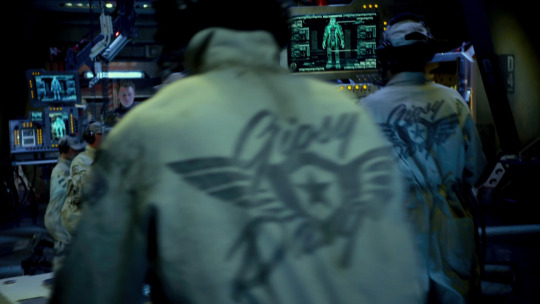
If you read my earlier post on jaegers, you know that drivesuits come in two layers. Here's Raleigh and Yancy already wearing the first layer, while one of their technicians assists:
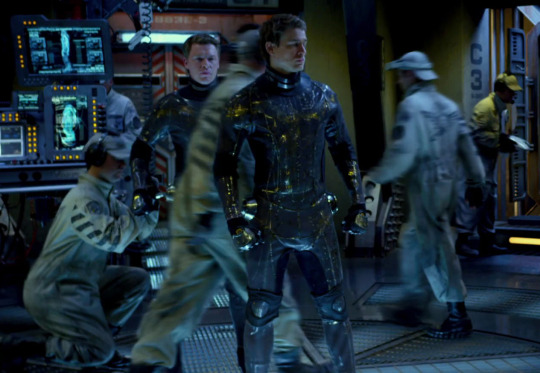
Next, the technicians help them into the drivesuit's second, armored layer. On the right side of the first image is the area where the drivesuits are kept when not in use:

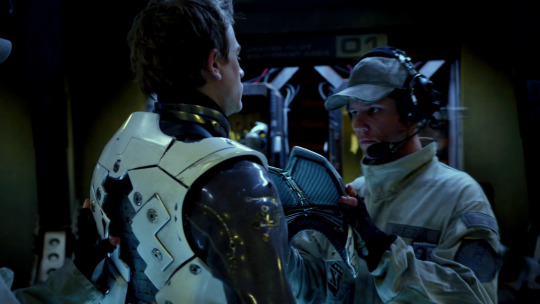
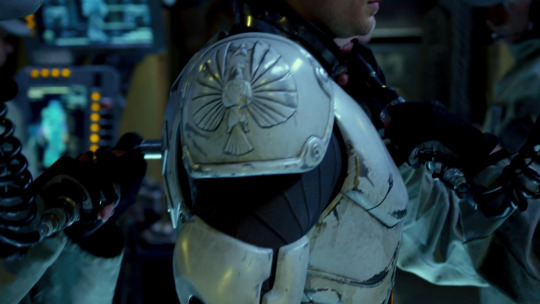
And then we have this thing that's pulled out of a special storage box and put over the spinal area, connecting the back of the armor together:

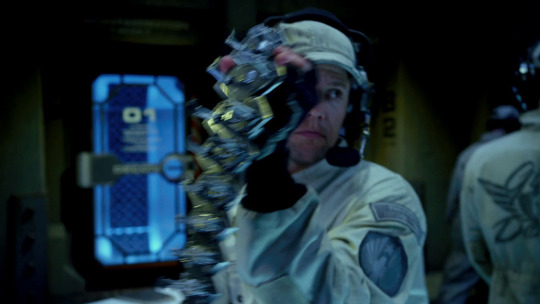

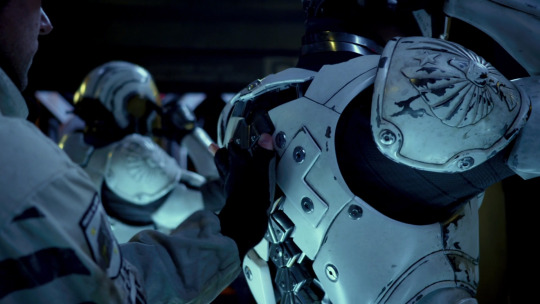
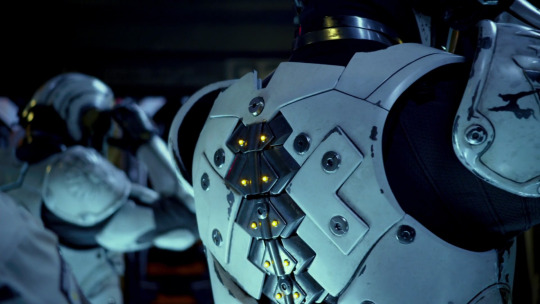
We also see Yancy and Raleigh pull on their helmets, and this strange liquid drains out. (It makes me think of the orange juice Raleigh was drinking earlier.) It's not clear how common this feature is, but we know it's not universal - the refurbished Lady Danger doesn't have this, and Cherno Alpha's helmets don't look it would even be possible.

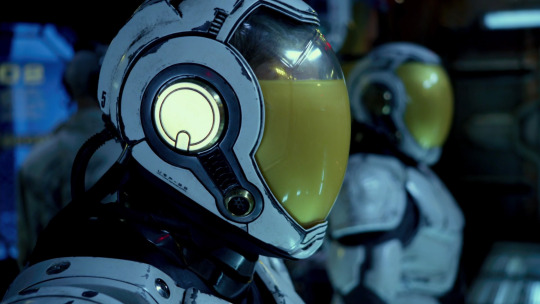
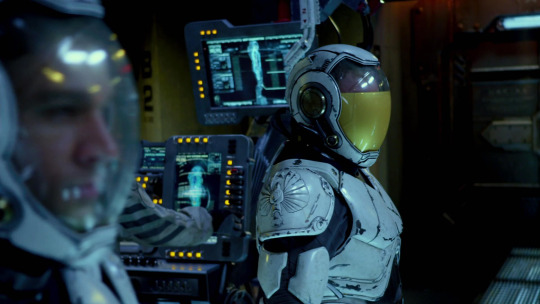
Next up, the pilots enter the conn-pod. Note those two light gray things on the floor in the first picture; that's part of the Pilot Motion Rig. Also note the dark gray things hanging from the ceiling in the second picture; that's also part of it.


Once the pilots step into the bottom part of Pilot Motion Rig, metal clamps lock their feet into place. On the right, Raleigh is already locked in; on the left, Yancy is not yet locked in:
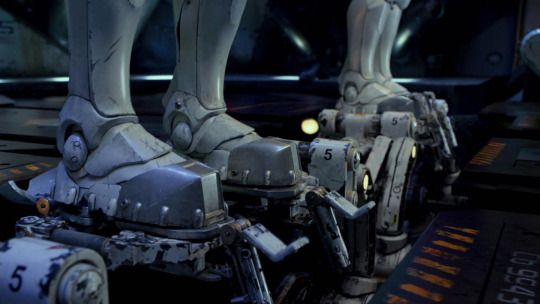
Meanwhile, more technicians help pilots get into the upper part of the Pilot Motion Rig.


At this point, something magical and wonderful absolutely terrifying else happens: the floor pulls away, leaving the pilots standing like:
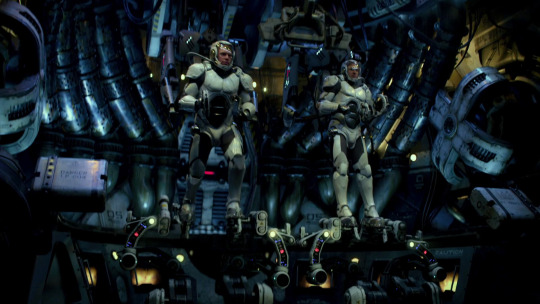
If you look down once the floor's pulled back, it's uh. Quite the view.
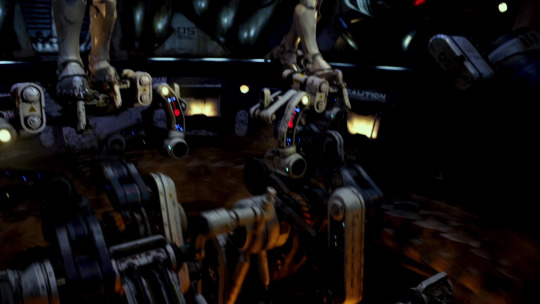
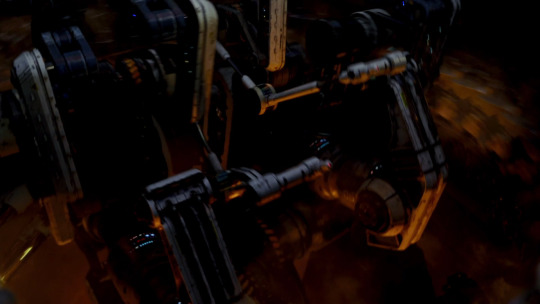
In the case of Lady Danger, a nuclear-powered Mark-3, this is where technicians drop the head to connect it to the body. (The head is stored separately to reduce radiation exposure that might damage the delicate circuits.)
At this point, the Beckets are looking at this in front of them:
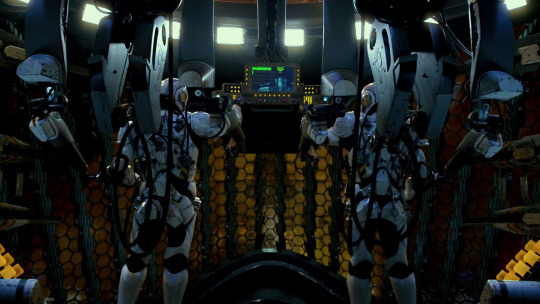
As the head connects, the pilot-to-pilot protocol is engaged, the computer system fires up, and the Beckets see a LOADING screen:

In the Anchorage Shatterdome, Lady Danger was wheeled out through a door on a rolling platform. At this point, the neural handshake was activated with a countdown of fifteen seconds.
The neural link is established, and you got two people in control of a Jaeger!
From here, stuff often depends on the specific jaeger, as control systems can be pretty different. For example, we see Raleigh and Yancy holding these round things in the arms they're controlling at the beginning of the film, but the refurbished Lady Danger doesn't seem to use them, and neither do the other jaegers.
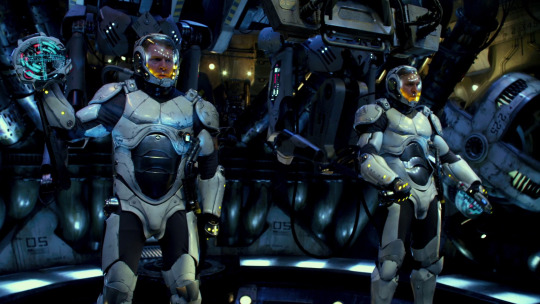
I'd also like to contrast Cherno Alpha's drivesuits with Lady Danger's drivesuits for a moment, just to emphasize how different designs can be. As you can see, each pilot's drivesuit has cables connected to the arm they're controlling:


Also as I was looking at pictures of jaeger interiors, I noticed something curious about Lady Danger vs. Striker Eureka.
The original Lady Danger has a high console like this:

The refurbished Lady Danger has one positioned lower:
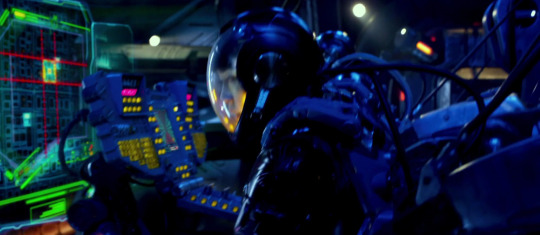
Striker Eureka has both a high and low console:

So make of that what you will, lol.
And that's the basics of boarding and controlling a jaeger! If you haven't seen it already I also recommend checking out my other post on jaeger lore, where I compiled everything I could find out about them from various Pacific Rim medias. And you might also read Drifting, as conceptualized by Travis Beacham if you're interested in knowing more about the drifting aspect, and maybe Drift Hangover Lore if the possibility of sentient jaegers appeals to you.
Happy monster punching, or whatever it is you people do out there. *Slinks back into the bog*
#pacific rim#pacific rim 2013#jaegers#jaeger#image heavy#pictures#screencaps#pacific rim lore#g slur warning#jaeger tech
137 notes
·
View notes
Text
I think "A.I." is having a Cybertruck Effect on all algorithmic computing, and that's not necessarily a good thing.
Like how people trusted Tesla and thought they were the future of the automotive industry... and then the Cybertruck came out and it made people reflect on the past with new perspective. Therefore, the Cybertruck retroactively obliterated everyone's trust in Tesla. People don't just distrust the Tesla Cybertruck, but anything Tesla is doing or making these days.
That's what "A.I." has done. Neural Networks and computer learning tasks have been around forever. Apple has been including Neural Engines on their phone CPUs since 2017. Enabling computer's to make "intelligent" decisions is nothing new, and it could actually be extremely useful in specific fields.
But because capitalism jumped the gun and started calling really bad LLM's, GenAI, and "smart" features "A.I." it's retroactively made everyone distrustful towards ALL computer learning tasks, even if they've been around for years or could be useful in the future.
22 notes
·
View notes
Text
OO Report RC7-42-OZ-4409
WARNING. Unauthorized sharing and viewing of this file is extremely strictly prohibited. All attempts to share by OO personnel WILL be immediately punished with lobotomy or death. Unauthorized civilians viewing this file are liable to be tracked, sued or even assassinated should they read any further.
23/8/2189, 02:38
Insertion to transfer orbit was successful. OZYMANDIAS is on a trajectory to its target orbit and will reach it within 30 years.
All systems confirmed operational. Automatic BNC checkup systems onboard OZYMANDIAS inform databases DC9-42-OZ-1, -2 and -3 of location, velocity and system health every standard day, 0:00 GMT. Communication with BNC systems available from terminals TC9-42-OZ-1, -2 and -3.
Conversations with OZYMANDIAS Neural Computer recommended daily, mental checkups weekly. Mental instability is considered unlikely even over long periods of no communication, but redundancy, trust and system health is of unparalleled importance. Communication with ONC is available from terminal TC10-42-OZ-4. Vocal communication is preferred, but text communication is possible for redundancy. Recommended education of ONC conversation partner is university level and recommended fields of expertise are philosophy, literature and neural computer engineering.
ONC mental checkup performer must be mentally stable, highly experienced with psychology and highly educated on theoretical NC science. They MUST NOT be underqualified or underexperienced. Level 3 background check is necessary. Head NC engineer of OZYMANDIAS is an acceptable backup option but we must not rely on them.
14 notes
·
View notes
Text
The human brain constantly produces impulses of neural energy, kind of like a mini power plant or inner engine. People differ in the intensity of these impulses. Some have a high "voltage", others - "low". And this generated neural energy (excitation) needs to be spent on some type of activities. This energy can reflect in how "jumpy" or visibly energetic a person is, but not nesessary.
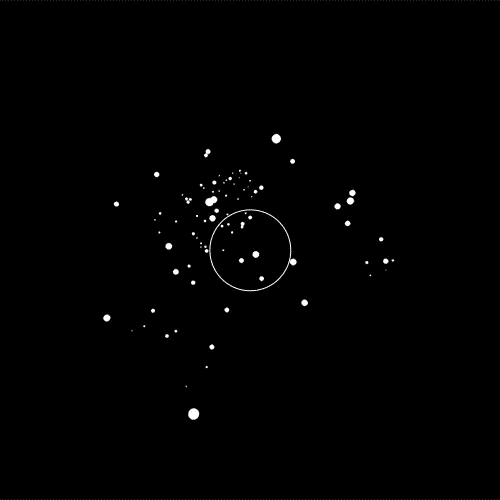
Both Mark and Doyoung have strong power plants within them. However, the way this energy is processed and spent varies significantly. Mark spends his a lot in a direct way - through work (long hours, big load), physical activity (the way his dance is super energised), loud voice and laugh, creativity (contemplating and writing, brainwork). I guess Christianity and faith help him to streamline his path as well, there are deep grooves to run along without unnesessary worry. He wants k-pop to be known around the world, the horizon is wide and there are many more mountains ahead, so he has no problem how to channel his energy. He juggles three teams, heh.
Doyoung is not a physical type, spending neural energy through pure physical activity (running, dancing) doesn't work for him. It tires him and the cells in the brain and muscles, eats up sugars, of course, but doesn't let him dispell the neural charge.
A normal active brain.


Doyoung's
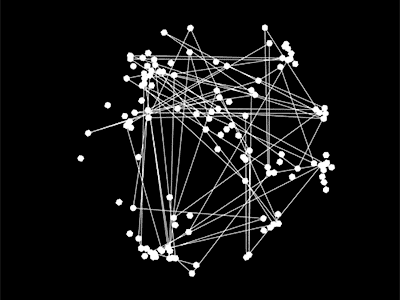
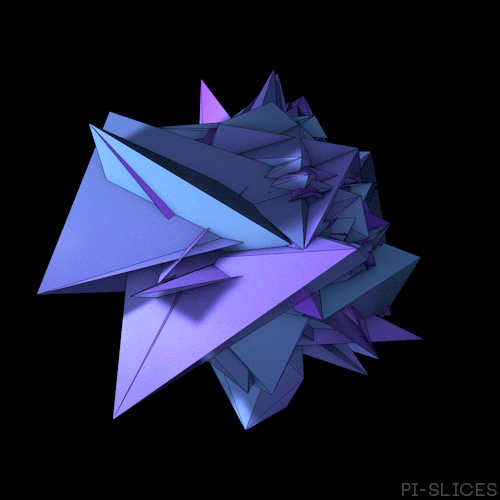
The energy still sips through the body in physical manifestations: a bouncing leg, walking on heels, cracking of knuckles, chirps, jumps, poking of others. However, it's not an outlet, just the energy leaking through cracks. Doyoung can't sit still and can't tolerate boredome. He needs to make himself busy and active.
I actually started to write this post because of this 2Dongs moment. An example of a very happy Doyoung unleashing his positive energy on a person nearby. Literally rubbing off the excessive charge, lol.
These last couple of shows gave us a new Doyoung - a Doyoung free of worries in his pure excited and content form. His solo career progresses well and he is working on his second album, WayV and Wish are doing well (NCT as a brand), 127 as well (the motivation of the members) despite the absence of Jae and Tae. Evidently currently there is a good dialogue with SM (A&R team, a good director for the concert, Mark and Hyuk getting their solos, (I assume) an appropriate budget for 127, etc). Also, Jaehyun should be settling well and also not complaining.

In the past Do demonstrated his energy through sassiness and wit (self-protection, he was establishing his position in the group, fought in the hierarchy games), worry and irritation (127 had troubles and didn't progress in popularity as quickly as Do hoped, a constant burden to succeed with every comeback, a chance to change the tide that had to be seized), nagging and micromanaging (the desire to move things, to get to the destination), even a burn-out and tears (when the body couldn't take the high voltage that wasn't spent properly, and a dam had to be broken for a forced release).
Doyoung spends his energy through reshaping the environment, influencing it somehow, making it better for people around him. He is the most grounded when he controls or affects in other way (singing, empathically) a large crowd. Not for the power, for the feeling of others being taken care of/doing well. Then his brain energy is properly channeled, the outflow is big (and there is none to remain and damage him from within). He is social and society oriented, his drive is to interact not with the natural world (nature, animals) or inner world (art, knowledge/science), but the society, other people.
When he talked of being bored being a child, his way out was to join clubs (like an art club), become a class president and run for the school student body. He cooked and invited friends to his house. He was hurt by being ostracised a lot and found salvation in singing (not a musical instrument or computer games, animals). Already then he demontrated how it was most natural for him to apply his energy.

When Do doesn't have things to worry about and people to micromanage (who do everything the right way without the need for him to intervene), his energy naturally emanates in a positive way: goofiness/playfulness, wide smiles and giggles (in the end), lightness, being hyper and extra, and boldness.
This moment (when Do asked the crowd of this size to repeat "2 Baddies" after him) especially demonstrated well the "expansion" (of his kekkai, lol) he does when he is in a right place mentally and occupationally.

It's important that Do said in public during his award speech that he worked hard. He is a perfectionist, he can easily find fault in anything, he is very demanding of himself, it's the first place or you are a loser mentality. So the fact that he is truly proud of himself and content of his own achievements (enough to praise and thank himself) is a sign of him being in a good mental shape and generally satisfied with how everything is going, with his life.
Even the eyes became rounder, hehe.

15 notes
·
View notes
Text
Jaegers of Pacific Rim: What do we know about them?
There's actually a fair amount of lore about Pacific Rim's jaegers, though most of it isn't actually in the movie itself. A lot of it has been scattered in places like Pacific Rim: Man, Machines, & Monsters, Tales From Year Zero, Travis Beacham's blog, and the Pacific Rim novelization.
Note that I will not be including information from either Pacific Rim: Uprising or Pacific Rim: The Black. Uprising didn't really add anything, and The Black's take on jaegers can easily be summed up as "simplified the concept to make a cartoon for children."
So what is there to know about jaegers, besides the fact that they're piloted by two people with their brains connected via computer?
Here's a fun fact: underneath the hull (which may or may not be pure iron), jaegers have "muscle strands" and liquid data transfer technology. Tendo Choi refers to them in the film when describing Lady Danger's repairs and upgrades:
Solid iron hull, no alloys. Forty engine blocks per muscle strand. Hyper-torque driver for every limb and a new fluid synapse system.
The novelization by Alex Irvine makes frequent references to this liquid data transfer tech. For example:
The Jaeger’s joints squealed and began to freeze up from loss of lubricant through the holes Knifehead had torn in it. Its liquid-circuit neural architecture was misfiring like crazy. (Page 29.)
He had enough fiber-optic and fluid-core cabling to get the bandwidth he needed. (Page 94.)
Newt soldered together a series of leads using the copper contact pins and short fluid-core cables. (Page 96.)
Unfortunately I haven't found anything more about the "muscle strands" and what they might be made of, but I do find it interesting that jaegers apparently have some sort of artificial muscle system going on, especially considering Newt's personnel dossier in the novel mentioned him pioneering research in artificial tissue replication at MIT.
The novelization also mentions that the pilots' drivesuits have a kind of recording device for their experiences while drifting:
This armored outer layer included a Drift recorder that automatically preserved sensory impressions. (Page 16.)
It was connected through a silver half-torus that looked like a travel pillow but was in fact a four-dimensional quantum recorder that would provide a full record of the Drift. (Page 96.)
This is certainly... quite the concept. Perhaps the PPDC has legitimate reasons for looking through the memories and feelings of their pilots, but let's not pretend this doesn't enable horrific levels of privacy invasion.
I must note, though, I haven't seen mention of a recording system anywhere outside of the novel. Travis Beacham doesn't mention it on his blog, and it never comes up in either Tales From Year Zero or Tales From The Drift, both written by him. Whether there just wasn't any occasion to mention it or whether this piece of worldbuilding fell by the wayside in Beacham's mind is currently impossible to determine.
Speaking of the drivesuits, let's talk about those more. The novelization includes a few paragraphs outlining how the pilots' drivesuits work. It's a two-layer deal:
The first layer, the circuity suit, was like a wetsuit threaded with a mesh of synaptic processors. The pattern of processor relays looked like circuitry on the outside of the suit, gleaming gold against its smooth black polymer material. These artificial synapses transmitted commands to the Jaeger’s motor systems as fast as the pilot’s brain could generate them, with lag times close to zero. The synaptic processor array also transmitted pain signals to the pilots when their Jaeger was damaged.
...
The second layer was a sealed polycarbonate shell with full life support and magnetic interfaces at spine, feet, and all major limb joints. It relayed neural signals both incoming and outgoing. This armored outer layer included a Drift recorder that automatically preserved sensory impressions.
...
The outer armored layer of the drivesuit also kept pilots locked into the Conn-Pod’s Pilot Motion Rig, a command platform with geared locks for the Rangers’ boots, cabled extensors that attached to each suit gauntlet, and a full-spectrum neural transference plate, called the feedback cradle, that locked from the Motion Rig to the spine of each Ranger’s suit. At the front of the motion rig stood a command console, but most of a Ranger’s commands were issued either by voice or through interaction with the holographic heads-up display projected into the space in front of the pilots’ faces. (Page 16.)
Now let's talk about the pons system. According to the novelization:
The basics of the Pons were simple. You needed an interface on each end, so neuro signals from the two brains could reach the central bridge. You needed a processor capable of organizing and merging the two sets of signals. You needed an output so the data generated by the Drift could be recorded, monitored, and analyzed. That was it. (Page 96.)
This is pretty consistent with other depictions of the drift, recording device aside. (Again, the 4D quantum recorder never comes up anywhere outside of the novel.)
The development of the pons system as we know it is depicted in Tales From Year Zero, which goes into further detail on what happened after Trespasser's attack on San Francisco. In this comic, a jaeger can be difficult to move if improbably calibrated. Stacker Pentecost testing out a single arm describes the experience as feeling like his hand is stuck in wet concrete; Doctor Caitlin Lightcap explains that it's resistance from the datastream because the interface isn't calibrated to Pentecost's neural profile. (I'm guessing that this is the kind of calibration the film refers to when Tendo Choi calls out Lady Danger's left and right hemispheres being calibrated.)
According to Travis Beacham's blog, solo piloting a jaeger for a short time is possible, though highly risky. While it won't cause lasting damage if the pilot survives the encounter, the neural overload that accumulates the longer a pilot goes on can be deadly. In this post he says:
It won't kill you right away. May take five minutes. May take twenty. No telling. But it gets more difficult the longer you try. And at some point it catches up with you. You won't last a whole fight start-to-finish. Stacker and Raleigh managed to get it done and unplug before hitting that wall.
In this post he says:
It starts off fine, but it's a steep curve from fine to dead. Most people can last five minutes. Far fewer can last thirty. Nobody can last a whole fight.
Next, let's talk about the size and weight of jaegers. Pacific Rim: Man, Machines, & Monsters lists off the sizes and weights of various jaegers. The heights of the jaegers it lists (which, to be clear, are not all of them) range from 224 feet to 280 feet. Their weights range from 1850 tons to 7890 tons. Worth noting, the heaviest jaegers (Romeo Blue and Horizon Brave) were among the Mark-1s, and it seems that these heavy builds didn't last long given that another Mark-1, Coyote Tango, weighed 2312 tons.
And on the topic of jaeger specs, each jaeger in Pacific Rim: Man, Machines, & Monsters is listed with a (fictional) power core and operating system. For example, Crimson Typhoon is powered by the Midnight Orb 9 power core, and runs on the Tri-Sun Plasma Gate OS.
Where the novelization's combat asset dossiers covers the same jaegers, this information lines up - with the exception of Lady Danger. PR:MMM says that Lady Danger's OS is Blue Spark 4.1; the novelization's dossier says it's BLPK 4.1.
PR:MMM also seems to have an incomplete list of the jaegers' armaments; for example, it lists the I-22 Plasmacaster under Weaponry, and "jet kick" under Power Moves. Meanwhile, the novelization presents its armaments thus:
I-22 Plasmacaster Twin Fist gripping claws, left arm only Enhanced balance systems and leg-integral Thrust Kickers Enhanced combat-strike armature on all limbs
The novel's dossiers list between 2-4 features in the jaegers' armaments sections.
Now let's move on to jaeger power cores. As many of you probably already know, Mark-1-3 jaegers were outfitted with nuclear power cores. However, this posed a risk of cancer for pilots, especially during the early days. To combat this, pilots were given the (fictional) anti-radiation drug, Metharocin. (We see Stacker Pentecost take Metharocin in the film.)
The Mark-4s and beyond were fitted with alternative fuel sources, although their exact nature isn't always clear. Striker Eureka's XIG supercell chamber implies some sort of giant cell batteries, but it's a little harder to guess what Crimson Typhoon's Midnight Orb 9 might be, aside from round.
Back on the topic of nuclear cores, though, the novelization contains a little paragraph about the inventor of Lady Danger's power core, which I found entertaining:
The old nuclear vortex turbine lifted away from the reactor housing. The reactor itself was a proprietary design, brainchild of an engineer who left Westinghouse when they wouldn’t let him use his lab to explore portable nuclear miniaturization tech. He’d landed with one of the contractors the PPDC brought in at its founding, and his small reactors powered many of the first three generations of Jaegers. (Page 182.)
Like... I have literally just met this character, and I love him. I want him to meet Newt Geiszler, you know? >:3
Apparently, escape pods were a new feature to Mark-3 jaegers. Text in the novelization says, "New to the Mark III is an automated escape-pod system capable of ejecting each Ranger individually." (Page 240.)
Finally, jaegers were always meant to be more than just machines. Their designs and movements were meant to convey personality and character. Pacific Rim: Man, Machines, & Monsters says:
Del Toro insisted the Jaegers be characters in and of themselves, not simply giant versions of their pilots. Del Toro told his designers, "It should be as painful for you to see a Jaeger get injured as it is for you to see the pilot [get hurt.]" (Page 56.)
Their weathered skins are inspired by combat-worn vehicles from the Iraq War and World War II battleships and bombers. They look believable and their design echoes human anatomy, but only to a point. "At the end of the day, what you want is for them to look cool," says Francisco Ruiz Velasco. "It's a summer movie, so you want to see some eye candy." Del Toro replies, "I, however, believe in 'eye protein,' which is high-end design with a high narrative content." (Page 57.)
THE JAEGER FROM DOWN UNDER is the only Mark 5, the most modern and best all-around athlete of the Jaegers. He's also the most brutal of the Jaeger force. Del Toro calls him "sort of brawler, like a bar fighter." (Page 64.)
And that is about all the info I could scrounge up and summarize in a post. I think there's a lot of interesting stuff here - like, I feel that the liquid circuit and muscle tissue stuff gives jaegers an eerily organic quality that could be played for some pretty interesting angles. And I also find it interesting that jaegers were meant to embody their own sort of character and personality, rather than just being simple combat machines or extensions of their pilots - it's a great example of a piece of media choosing thematic correctness over technical correctness, which when you get right down to it, is sort of what Pacific Rim is really all about.
106 notes
·
View notes
Text
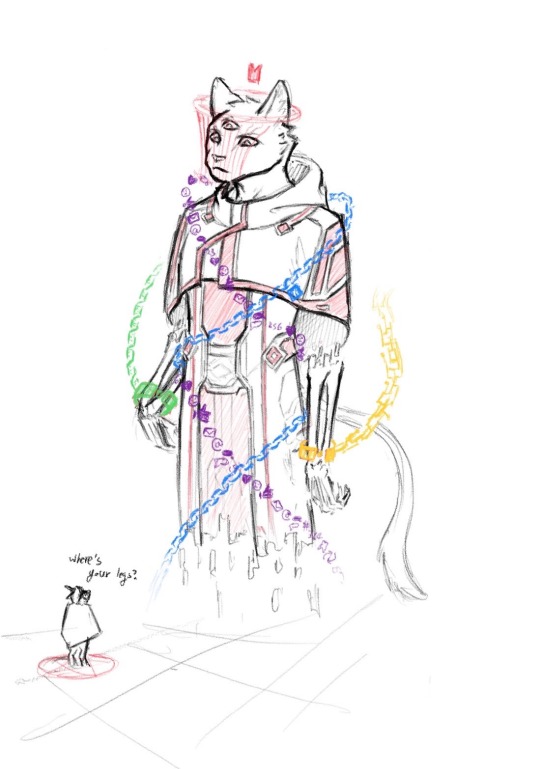
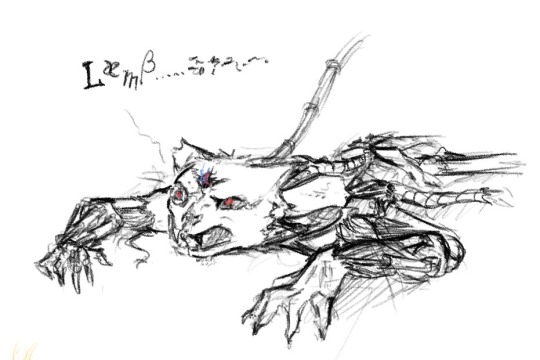

Just some ideas that I really need to flush out of my head so I can continue my life. I know close to nothing about computer, and I didn’t really think this through so I hope it makes sense.
This is a sci-fi AU, which the crowns function as servers governing every aspect of their people’s lives, while the bishops serve as administrators overseeing these servers.
Narinder makes a discovery: the ability to upload a person’s mind onto his server. Recognizing the potential threat of Narinder gaining ultimate control by plundering minds and recreating reality in virtual form, the rest of the bishop lock Narinder’s mind in his server with his own method.
The bishops disconnect everyone’s neural chips from the red server. However, they find that the connection between the red server and the neural chips designed for lambs cannot be fully severed. So they decide to kill them all.
Due to the unstable connection, the last lamb is the only one with enough uploaded information to function properly.
Ratau becomes a former vessel by accidentally connecting himself to the red server while looting the abandoned server building.
Servers and their domains:
Red server- data storage, information technology
Green server- eco system, bio engineering
Yellow server- resource, transportation
Blue server- security system
Purple server- social media, communication, television
Resurrection- making backups of memories and personalities
Death for lamb= current body damaged, upload save to new body back in the cult
Relics- chips that allow lamb to access some functions from abandoned servers
Curses- Access into either enemy or environment’s system to trigger certain actions.
Birds (Clauneck, Kudaai, Chemach)- first generation sentient AI
Wounds on bishops- data got permanently corrupted? Or the code Narinder uploaded onto them can’t be removed by the knowledge they have? So even when they change the damaged parts it’s still not working?
47 notes
·
View notes
Text
the conversation around generative neural networks is a dumpster fire in a dozen different ways but I think the part that disproportionately frustrates me, like on an irrational pet peeve level, is that nobody in that conversation seems to understand automata theory
back before most of these deep learning techniques were a twinkle in a theorist's eye, back when computing was a lot less engineering and a lot more math, computer scientists had worked out the math of different "classes" of computer system and what kinds of problems they could and couldn't solve
these aren't arbitrary classifications like most taxonomy turns out to be. there's qualitative differences. you can draw hard lines: "it takes class X or above to run programs with Y trait", and "only class X programs or below are guaranteed to have Y trait". and all of those lines have been mathematically proven; if you ever found a counterexample, then we'd be in "math is a lot of bunk" territory and we'd have way bigger things to worry about
this has nothing to do with how fast/slow the computer system goes; it's about "what kinds of program can it run at all". so it includes emulation and such. you can emulate a lower system in a higher one, but not vice versa
at the top of this heap is turing machines, which includes most computers we'd bother to build. there's a lot of programs that it's been mathematically proven require at least a turing machine to run. and this class of programs includes a lot of things that humans can do, too
but with this power comes some inevitable restrictions. for example, if you feed a program to a turing machine, there's no way to guarantee that the program will finish; it might get stuck somewhere and loop forever. in fact there's some programs that you straight up can't predict whether they'll ever finish even if you're looking at the code yourself
these two are intrinsically linked. if your program solves a turing complete problem, it needs a turing machine; nothing less will do. and a turing machine is capable of running all such programs, given enough time.
ok. great. what does any of that jargon have to do with AI?
well... the important thing to know is that the machine learning models we're using right now can't loop forever. if they could loop forever they couldn't be trained. for any given input, they'll produce an output in finite time
which means... well, any program that requires a turing machine to run, or even requires a push-down automaton to run (a weaker type of computer system that can get into infinite loops but that you can at least check ahead of time if a program will get stuck or not), can't be emulated by these systems. they've got to be in the next category down: finite state machines at most - and thus unable to compute, or emulate computation of, programs that inhabit a higher tier
and there is a heck of a lot of stuff we conceptualize as "thinking" that doesn't fit in a finite state machine
...I suspect it will some day be possible for a computer program to be a person. I am absolutely certain that when that day comes, the computer program who's a person would require at least a turing machine to run them
what we have right now isn't that. what we have right now is eye spots on moths, bee orchids, mockingbirds. it might be "artificial intelligence", depending on your definition of "intelligence", but prompt it to do things that we've proven only a turing machine can do, and it will fall over
and the reason I consider this an "irrational pet peeve" and not something more severe? is because this information doesn't actually help solve policy questions! if this is a tool, then we still need to decide how we're going to allow such tools to be built, and used. it's not as simple as a blanket ban, and it's not as simple as letting the output of GNNs fully launder the input, because either of those "simple" solutions are rife for abuse
but I can't help but feel like the conversation is in part held back by specious "is a GNN a people" arguments on the one hand, and "can a GNN actually replace writers, or is it just fooling execs into thinking it can" arguments on the other, when the answer to both seems to me like it was solved 40 years ago
228 notes
·
View notes